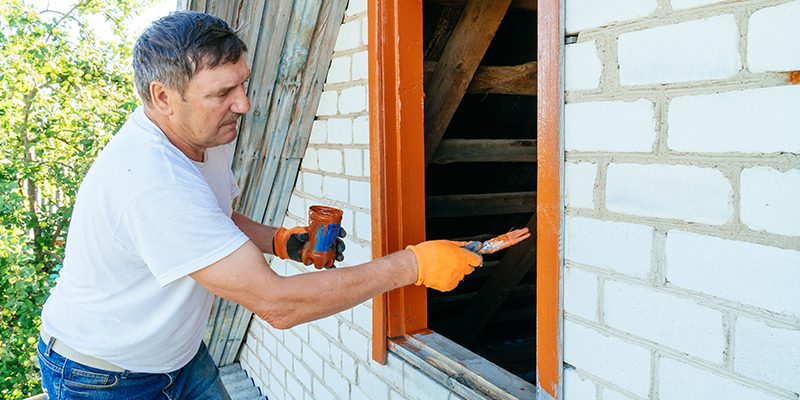Are you looking for ways to replace windows in your old brick house? Whether you are annoyed by the uncomfortable drafts or want to upgrade the look of your windows, you can do it yourself.
So, if you are wondering how to replace windows in a brick house on your own, this guide can help you. Pay careful attention to every step to give a new look to your house’s interiors and exteriors.
Steps to Follow for Replacing Windows in a Brick Wall
Prep The Window Opening
Pull The Window: Remove the sash, the balance system, and the storm windows. Then, cut the frame in frame into pieces and pull them out. Cut the nails attached to the wall sheathing to prevent damage.
Go Slow: Follow a go-slow approach to pull the old window frame and not damage the plaster or drywall.
Expose The Weather Barrier: Remember that you have to integrate the new window with the existing felt. However, there will be chunks of mortar around the opening, which need to be removed using an angular grinder and a chisel without cutting the building paper.
Add a Rough Opening: Use 1x and 2x lumber to shrink the frame, matching the window’s rough opening. The nailing flange of the window can fit inside the masonry through the small opening.
Flash The Rough Opening
Wrap The Sheathing: As there will be no room for adding weatherproof over the sheathing patches, you can cover the patches with a thin flashing take before you install them.
Slip in The Sheathing: The sheathing patches around the new opening are arranged carefully behind the existing weatherproofing. Use a knife to hold back the old felt and push the patches behind it.
Leave a Flap at The Top: The sheathing patch at the top of the window opening has another flap of flashing tape. Just leave the release paper on the flap to tuck the head and top flange under the flap. It will help to integrate them into your house’s drainage plan.
Create a Site-Built Sill Pan
Extend The WeatherProofing: The aluminum flashing offers an extension of the weatherproof barrier to the new sill. This flashing overlaps the old felt and is tacked in place with aluminum trim nails. Don’t worry about the loose flap of the tape in the corners of the opening, as they will get overlapped by the sill-pan flashing.
Create a Back Dam: Create a back dam to prevent unfiltered water from getting inside the house. You can temporarily use a piece of vinyl wall edging and flashing tape to create a low-grade back dam. Later, you can cover it with the flexible sill pan.
Use Sill Pan to Stop Water: After you remove the release paper, insert a piece of DuPont FlexWrap to act as a sill-pan flashing. Also, you must ensure that the flashing corners are pressed hard to the opening where the sill meets the jack studs and make a tight 90° corner. Or, the window frame needs to be cut through the pan flashing while pushing the window to open.
Add a Storm Flap: If you want to prevent rain during storms from getting inside your house, install a storm flap on the top of the brick sill. It is even more necessary for second-story windows as it can be hard to know the condition of their weatherproof barriers.
Install The Window
Caulk The Nailing Flange: Put a heavy bead of sealant around the window’s side and top nailing flanges. Don’t seal the bottom part; it will allow any unfiltered water to drain. Also, ensure that the flashing and sealants are compatible, as some don’t work along. Rest the frame in the rough sill while keeping it centered in the rough opening. Then, tilt the window and slowly place it into the space. Use two 1 – ¼ inches pan-head screws to secure the nailing flange.
Shim The Jambs: Shim the frame straight before you fully tighten the nailing flange on the exterior. Otherwise, the window will not open. Once you shim the unit, tighten the nailing flange.
Foam The Gap: Use window-and-door foam to fill the empty space between the window frame and the rough opening. For the bottom part, fill the foam only an inch to stop air but allow water to flow.
Cover The Flange: Cover the side and the top flanges with foil-faced flashing tape. The foil tape has a less tenacious adhesive, making it easier to tuck the tape behind the brick. Tuck its top edge below the flap, created with the first flashing tape on the sheathing patches.
Extra Sealing
Cover The Drip Cap: The foil flashing layer above the head flashing integrates the head flashing into the drainage plane. You can tuck the top edge of the self-adhesive flashing under the flap left in the weatherproof barrier tape covering the patch of the sheathing.
Slip in a Head Flashing: A flashing bent in an L-shape sheds water over the casting. Tuck its vertical leg under the flap left in the weatherproofing tape. It also helps in shielding the foil tape over the head flashing.
Install The Casing: Get cellular PVC casing and secure corners with pocket screws. You can get stainless-steel trim-head screws to make the installation easier.
Seal and Trim The Storm Flap: Use sealant under the flap to keep it in place and prevent rainwater from entering during storms.
Caulk The Trim: The last step is to caulk the window frame casing and the brick veneer with a sealant. However, don’t caulk the head casing and weep holes at the bottom.
Common Mistakes to Avoid During Window Installation
Inattentive measurements.
Prying directly on the brick veneer can lead to its breaking.
Pulling and jerking the nail out forcibly, causing flaws in the brickwork.
Not smoothing out the caulking enough, leading to a rough and uneven surface.
The Final Takeaway
Replacing a window in a brick house can be challenging. Still, you can give it a try following this guide on how to replace windows in a brick house. However, if it seems too hard for you to do, reaching out for professional help is the right thing to do.

Hi, I’m Lillian Blanchard, a home solutions expert and writer with a passion for transforming everyday spaces into functional, beautiful havens. With years of experience in interior design, DIY projects, and sustainable living, I specialize in crafting practical advice that makes home improvement accessible to everyone.








